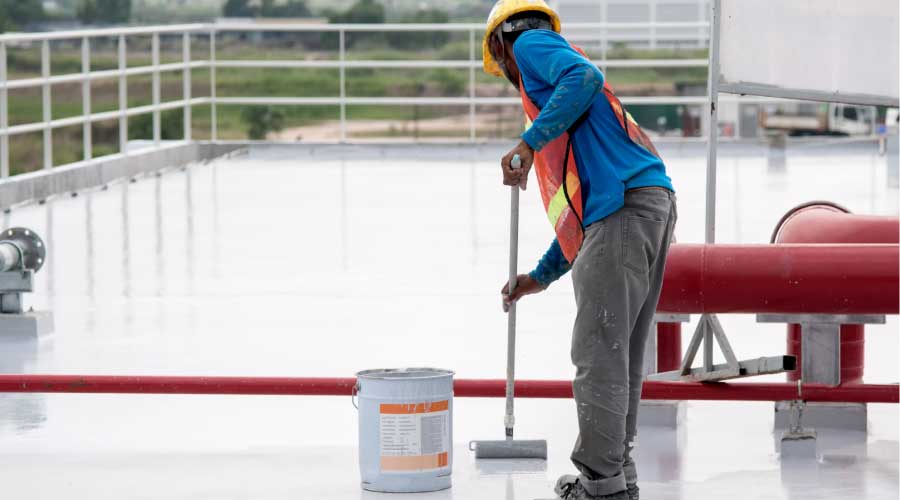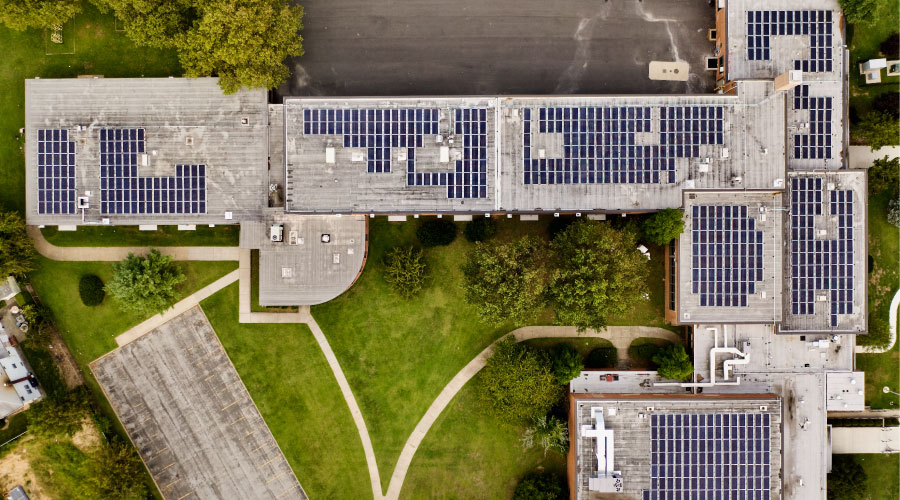Roof Inspections: A Closer Look
Savvy roof management starts with gathering detailed data on a system’s condition
Rare is the organization in which roofing funds flow like water. Most maintenance managers face the quandary of too many problem roofs for the money available. While the lack of money might be one problem, more often the problem is the lack of a coherent roof-management plan.
In theory, most managers of commercial and institutional facilities agree that regular inspections are an essential for successful roof management. They also recognize and agree with the basic roof-management tenet that regular inspections and routine maintenance reduce ownership costs, reduce leak frequency and severity, extend roof life, and reduce management inefficiencies.
Motivation Matters
By the time many organizations consider implementing a roof-management plan, they actually need a roof-replacement program. The obligation to fund and implement roof replacements has trumped any opportunities to maintain and repair roofs.
If a manager can extend the life of each roof by one year, the organization can break even on the cost of a roof-management plan. If a manager can extend each roof’s life by two or three years, the plan can reduce roof expenditures by a multiple of its costs.
So why don’t most organizations have a viable inspection and maintenance plan? Is it inertia, or a “We’ve never done it that way before” mentality, or a fear of the unknown? It’s hard to fathom. What is certain, though, is that most plans never get started. What also is certain is that even a minimal plan is better than no plan.
Taking Stock
Once a manager commits to a program, the first step toward implementation is getting organized, which includes laying out a plan and assigning someone to be in charge of the program. Annual inspections and maintenance are the key components in preventing major expenditures for premature roof replacement.
The temptation in beginning a roof-management program is to start filling pitch pans. This step would be a definite improvement over no effort. But the best first step is to take an inventory of all roofs. This process begins with developing a historical file for each roof that includes:
-
date of installation
-
installing contractor
-
system manufacturer
-
warranties
-
type of roof system, insulation, and roof deck
-
leak history
-
repair history, dates, type, and cost of repairs.
Condition Considerations
With the roof information in place, the next step is to get up on the roofs and perform a condition assessment. No roof can be managed appropriately without knowing its history and understanding its condition, information that comes from conducting a roof inspection.
Workers can conduct two types of inspections: visual and non-destructive.
Visual inspections should occur semi-annually or annually, depending on the roof’s condition, the amount of rooftop traffic, and the sensitivity of occupants.
Non-destructive inspections can complement — but should never replace — visual inspections. Non-destructive measures include infrared, nuclear, and capacitance tests. These inspections can confirm the presence of moisture, establish a baseline for roof management, locate hard-to-find leaks, and authenticate the need for full or partial re-roofing projects.
The person performing visual roof surveys should be very familiar with the design, installation, repair, and types of failure specific to the roof system being surveyed. Whether surveys are done by in-house staff or contracted to a consultant depends on the technical competence and availability of in-house resources. In-house personnel trained in roof inspection, diagnosis and repair can perform limited overview surveys.
A visual survey should include:
-
an examination of the roof system, flashings, sheet-metal flashings, drains, and gutters
-
an evaluation of observed conditions that might affect the long-term performance of the roof system
-
documentation of deficiencies requiring corrective action
-
other information needed for developing long-range preventive maintenance (PM) needs.
Survey documentation should consist of a written report or checklist, photographs and notes on a roof plan indicating the conditions observed. The roof plan should supply enough data to enable the performance of the required repairs.
By noting the perimeters of all roof sections, as well as the location of all major rooftop equipment, an accurate and detailed roof plan becomes an important piece of the management puzzle. In the event repairs require the presence of a roofing professional, this plan can serve as the basis of a punchlist for the contractor.
The frequency of tasks associated with roof PM depends on the roof’s age and condition, environmental conditions, rooftop traffic, occupancy sensitivity, size, and roof accessibility. Managers can use the following guidelines when determining frequency:
-
Perform comprehensive visual roof surveys semi-annually.
-
Conduct warranty surveys before a contractor or manufacturer warranty expires.
-
Perform housekeeping surveys on most roof areas monthly. Housekeep-ing surveys should include cleaning roof drains, replacing misplaced drain covers, removing debris, sealing seam voids, caulking where needed, and filling pitch pans.
-
Schedule corrective steps or repairs soon after the survey to minimize unnecessary costs due to water intrusion.
Formulating a Plan
The information gathered on a roof’s condition does no good if it sits on a shelf gathering dust. The data needs to be recorded and studied in order to help managers identify the opportunities to make repairs, conduct maintenance or plan for re-roofing. The plan also will help managers communicate better with upper management, the roofing contractor and maintenance staff.
Despite the funds, staff hours and dedication required to set up a roof-management program, the benefits of the effort far outweigh the costs. If managers create and manage the program effectively, roofs will last longer, perform better and leak less.
More importantly, if managers commit their departments to performing annual roof PM rather than waiting for a leak to occur before responding, facility operations also will suffer fewer interruptions.
Managers who develop a detailed and well-organized plan will have a better idea about where problematic areas exist and will be able to work toward budget approval for repairs more effectively. Obviously, a plan does not necessarily guarantee that top management will automatically approve all roofing budget requests. But at least the manager will be well equipped with the tools necessary to justify the large expense.
Jeff Evans, RRC, is a senior consultant and vice president at Benchmark Inc. — (319) 393-9100 — a professional roof and pavement consulting company in Cedar Rapids, Iowa. Benchmark has been developing roof and pavement management programs for more than 23 years.
Focus on ‘Green’ Roofs
With green roofs — those featuring vegetation — springing up more often across the country, maintenance managers need to consider the best way to inspect and maintain these systems. Their efforts, however, depend on the kind of green roof installed and the way the owner intends to use it.
Generally, after the plants are established on a green roof, most such roofs only require weeding and occasional infill transplanting, perhaps twice a year. Workers should time their maintenance visits to remove weeds before they go to seed. This level of maintenance is enough to maintain the health of the plants and protect the underlying roofing materials.
Some owners are more involved in the process and choose to “garden” in their green roof more frequently. Such intensive green roofs require the same care and maintenance as a garden situated on the ground.
Among the issues managers need to consider in planning for inspection and maintenance of green roofs are these:
-
Plant condition. Are they healthy?
-
Uncontrolled or overgrown vegetation
-
Weeds growing among the plants
-
Signs of disease or pest damage
-
Moisture levels. Water plants if rainfall drought exceeds three to four weeks. Watering new green roofs every other day until the plant roots are established is ideal.
-
Does the irrigation system work properly?
-
Do dead plants need to be removed or replaced?
-
Root penetration or other physical damage to the roof membrane
-
Open flashing membrane seams and terminations, water seepage, and membrane delamination, along the edges and outside the green roof area
-
Signs of soil erosion and soil overflow at retention walls
-
Accumulation of fallen leaves, mud, soil, and weeds located in drains.
— Jeff Evans
|
Inspection Strategy: The Worst Shall Be First
Don’t be one of those managers whose roof requires replacement before their reaching its design life, or for whom emergency repairs are needed at the worst time. In short, don’t neglect good roofs and doom them to early failure. Periodic inspection and maintenance of roofing assets are the most important elements of a successful roof-management program.
One recommended strategy might be described as “top down, bottom up.” Managers can succeed more quickly by focusing on roofs in the worst condition — those at the top of the priority list — while still attending to those at the bottom of the list — those in good condition and performing well.
The strategy calls for directing most available funds toward putting out immediate emergencies, such as severe leaks. At the same time, some funds also must go toward prolonging the life of newer roofs.
Using this two-pronged approach, managers can ensure other roofs in their portfolios do not need to be replaced prematurely.
— Jeff Evans
|
Related Topics:











